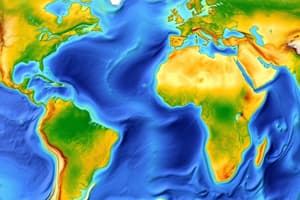Podcast
Questions and Answers
What is the role of the thermohaline circulation in regulating global climate patterns?
What is the role of the thermohaline circulation in regulating global climate patterns?
It plays a significant role in regulating global climate patterns.
How are rising sea surface temperatures (SSTs) globally related to climate change?
How are rising sea surface temperatures (SSTs) globally related to climate change?
Rising SSTs globally are strongly related to climate change caused by human activities.
Explain how greenhouse gases affect ocean temperatures and subsequently impact SSTs.
Explain how greenhouse gases affect ocean temperatures and subsequently impact SSTs.
Greenhouse gases trap heat in the Earth's atmosphere, leading to an increase in ocean temperatures and influencing SSTs.
What role do satellites equipped with thermal infrared sensors play in monitoring SSTs?
What role do satellites equipped with thermal infrared sensors play in monitoring SSTs?
How can the study of SSTs contribute to our understanding of El Niño and La Niña events?
How can the study of SSTs contribute to our understanding of El Niño and La Niña events?
What is the difference between SST and Sea Surface Temperature (SST)?
What is the difference between SST and Sea Surface Temperature (SST)?
How do El Niño and La Niña events affect global weather patterns?
How do El Niño and La Niña events affect global weather patterns?
What drives the thermohaline circulation, also known as the global conveyor belt?
What drives the thermohaline circulation, also known as the global conveyor belt?
Explain how the temperature gradient changes with depth in the ocean.
Explain how the temperature gradient changes with depth in the ocean.
What are the main characteristics of El Niño and La Niña in terms of SST?
What are the main characteristics of El Niño and La Niña in terms of SST?
Why does warm water float on top of colder, denser water in the thermohaline circulation system?
Why does warm water float on top of colder, denser water in the thermohaline circulation system?
Study Notes
SST (Subsurface Temperature) Overview
The Subsurface Temperature (SST) refers to the water temperature at depths below the ocean's surface. This temperature plays a crucial role in multiple oceanic processes and is a vital parameter for understanding climate patterns and forecasting weather. Let's explore the five subtopics that further illuminate the significance of SST.
SST Topic 1: Divergence from Surface Temperature
SST differs from the water temperature at the ocean's surface, known as Sea Surface Temperature (SST). The upper layer of the ocean can be heated by solar radiation, while the deeper layers are relatively cooler. As a result, the temperature gradient between surface and subsurface waters increases with depth.
SST Topic 2: El Niño and La Niña
El Niño and La Niña, two climate events, are driven by changes in SST in the equatorial Pacific. During an El Niño, warmer-than-normal SSTs occur in the eastern Pacific, altering atmospheric and oceanic patterns in ways that can disrupt weather patterns worldwide. Conversely, La Niña results from cooler-than-normal SSTs in the eastern Pacific, causing global weather patterns to shift in response.
SST Topic 3: Thermohaline Circulation
The thermohaline circulation, also known as the global conveyor belt, is a system of ocean currents driven by water density differences that result from temperature and salinity gradients. Warm water is less dense and floats on top of colder, denser water. The thermohaline circulation plays a significant role in regulating global climate patterns.
SST Topic 4: Ocean Heat Uptake and Climate Warming
SSTs have risen globally in the past several decades, a phenomenon that is strongly related to climate change caused by human activities. As greenhouse gases trap heat in the Earth's atmosphere, ocean temperatures increase, influencing SSTs.
SST Topic 5: Satellite Observations and Remote Sensing
Satellites equipped with thermal infrared sensors can measure SSTs with high spatial resolution and frequency. This remotely sensed data provides valuable information for weather forecasting, climate research, and understanding the drivers of El Niño and La Niña events.
In summary, SST is a crucial parameter for monitoring climate patterns, ocean currents, and weather forecasting. Its study can help us understand global climate change and its impacts on the Earth's ecosystems and human societies.
Studying That Suits You
Use AI to generate personalized quizzes and flashcards to suit your learning preferences.
Description
Test your knowledge on Subsurface Temperature (SST) and its significance in understanding climate patterns, ocean currents, and weather forecasting. Explore topics like SST divergence, El Niño and La Niña events, thermohaline circulation, ocean heat uptake, and satellite observations.




